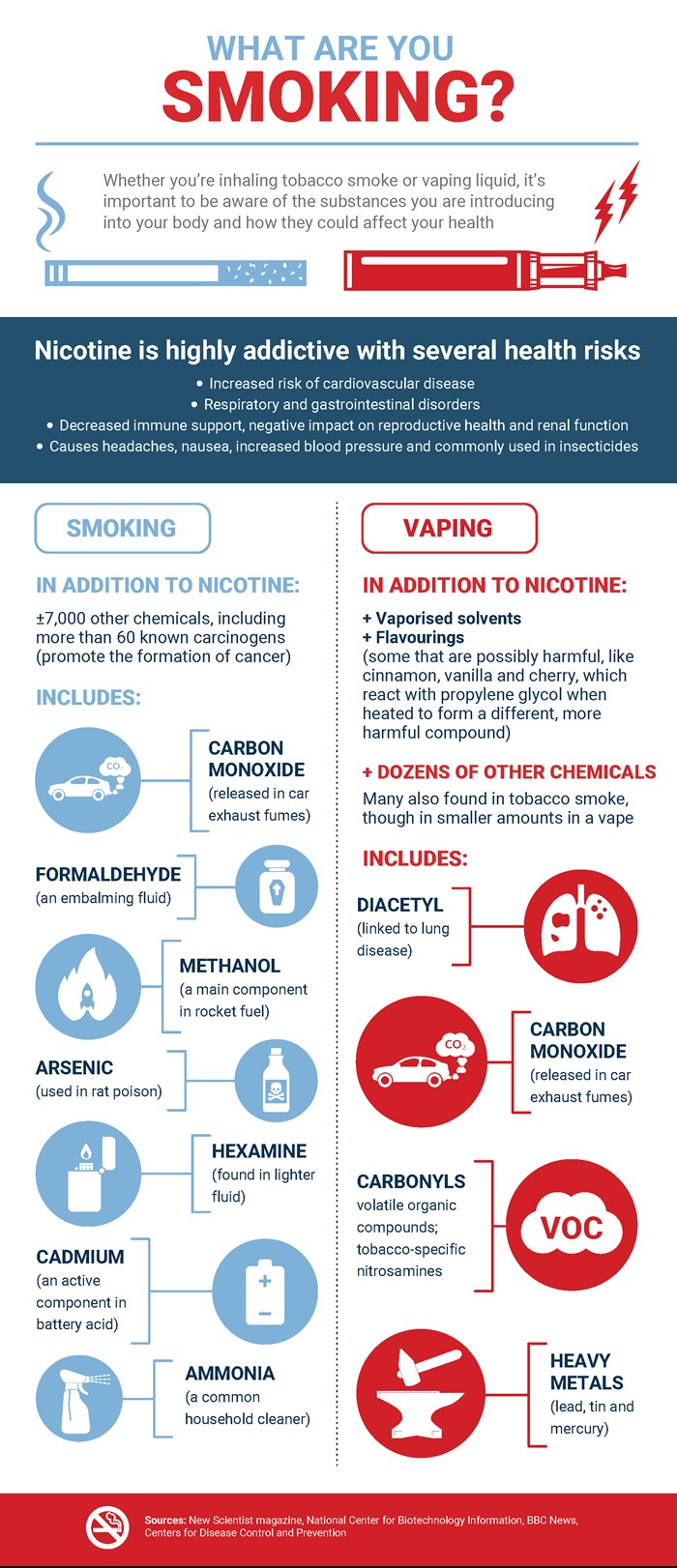What’s in a cigarette?

Smoking results in millions of deaths every year, but what’s in cigarettes that makes them so harmful?
The World Health Organization (WHO) estimates that there are approximately one billion smokers in the world, which is about a seventh of the world’s population. Whether you’re an active smoker or have been subjected to second-hand smoke, it’s important to be aware of your exposure to harmful components in cigarettes and e-cigarettes and their effect on your health.
The tobacco epidemic
When a cigarette burns, it releases a range of toxic chemicals – many of which cause cancer. The American Lung Association estimates that there are 600 ingredients in a single cigarette and when one is burning, 7,000 highly toxic chemicals are created. When these substances are included in consumer products, they carry a health warning, but there is no such warning about the harmful substances in tobacco. Nicotine is one of the most harmful, as it is highly addictive and alters brain chemistry.
Is vapour smoke bad?
There’s a lot we don’t know about the safety and side effects of vape liquid or vape juice in e-cigarettes. However, there are more studies every day that caution users about the harmful ingredients, including nicotine, heavy metals and flavourings that become toxic when heated and bonded with other chemicals. There is evidence that lung-tissue damage is possible with prolonged use.
The main components of the vape liquid is nicotine mixed with a base (usually propylene glycol) as well as flavourings, colourings and other chemicals, such as formaldehyde (embalming liquid) and acrolein, which can cause irreversible lung damage.
Here’s a more detailed look at what exactly you’re smoking:


Health effects of smoking
According to the Heart and Stroke Foundation South Africa, smoking almost triples the risk of heart disease and more than doubles the risk of stroke. Nicotine can also affect fertility and cause reproductive, renal (kidney) and neurological complications and related cancers, among others.
Contrary to what is sometimes reported, it’s not just water vapour in an e-cigarette. A recent study found adolescent e-cigarette smokers’ urine tested positive for at least five of the same cancer-causing chemicals found in traditional cigarettes and since anyone who smokes an e-cigarette is inhaling nicotine in varying degrees, there should be caution about its use.
Effect on the lungs
- Smoking: Smoking a cigarette or passive exposure to cigarette smoke reduces lung function by about 7%.
- Vaping: One British study reports that with or without nicotine, e-cigarette vapour increases inflammation and disables cells that protect lung tissue.
Effect on the heart
- Smoking: Smoking cigarettes causes significant rises in blood pressure and heart rate.
- Vaping: Vapers show a small increase in blood pressure. However, any increase is a risk factor for cardiovascular disease.
Effect on the immune system
- Smoking: Cigarette smoke contains high levels of tar and other chemicals, which make your immune system less effective at fighting off infections.
- Vaping: In 2018, BBC News reported that e-cigarette vapour disabled important immune cells in the lungs and boosted inflammation.
Effects on the brain
- Smoking: Nicotine changes the brain chemistry, making nicotine addiction hard to beat. The absence of nicotine can make you irritable, anxious and depressed.
- Vaping: The Centers for Disease Control and Prevention (CDC) in the US reports that taking in nicotine in adolescence increases the risk of developing psychiatric disorders and cognitive impairment later in life. Nicotine affects the area of the brain responsible for attention, memory, learning and brain plasticity.
While it’s never easy to quit, the health benefits are clear.
The information is shared on condition that readers will make their own determination, including seeking advice from a healthcare professional. E&OE. Life Healthcare Group Ltd does not accept any responsibility for any loss or damage suffered by the reader as a result of the information provided.

